Uffizi
|
Narrow courtyard between palace's two wings with view toward the Arno | |
| Established | 1581 |
|---|---|
| Location |
Piazzale degli Uffizi, 50122 Florence, Italy |
| Type | Art museum, Design/Textile Museum, Historic site |
| Visitors |
2.02 million (2016)[1] Ranked 25th globally in 2013[2] |
| Website | www.uffizi.it |

The Uffizi Gallery (Italian: Galleria degli Uffizi, pronounced [ɡalleˈriːa deʎʎ ufˈfittsi]) is a prominent art museum located adjacent to the Piazza della Signoria in the Historic Centre of Florence in the region of Tuscany, Italy. One of the most important Italian museums, and the most visited, it is also one of the largest and best known in the world, and holds a collection of priceless works, particularly from the period of the Italian Renaissance.
After the ruling house of Medici died out, their art collections were gifted to the city of Florence under the famous Patto di famiglia negotiated by Anna Maria Luisa, the last Medici heiress. The Uffizi is one of the first modern museums. The gallery had been open to visitors by request since the sixteenth century, and in 1765 it was officially opened to the public, formally becoming a museum in 1865.[3]
Today, the Uffizi is one of the most popular tourist attractions of Florence. The Uffizi hosted over two million visitors in 2016, making it the most visited art gallary in Italy.[4] In high season (particularly in July), waiting times can be up to five hours. Tickets are available on-line in advance, however, to significantly reduce the waiting time.[5] The museum is being renovated to more than double the number of rooms used to display artwork.[6]
History
The building of Uffizi complex was begun by Giorgio Vasari in 1560 for Cosimo I de' Medici so as to accommodate the offices of the Florentine magistrates, hence the name uffizi, "offices". The construction was later continued by Alfonso Parigi and Bernardo Buontalenti; it was completed in 1581. The top floor was made into a gallery for the family and their guests and included their collection of Roman sculptures. [7]
The cortile (internal courtyard) is so long and narrow, and open to the Arno at its far end through a Doric screen that articulates the space without blocking it, that architectural historians[8] treat it as the first regularized streetscape of Europe. Vasari, a painter and architect as well, emphasised its perspective length by the matching facades' continuous roof cornices, and unbroken cornices between storeys and the three continuous steps on which the palace-fronts stand. The niches in the piers that alternate with columns filled with sculptures of famous artists in the 19th century.

The Uffizi brought together under one roof the administrative offices and the Archivio di Stato, the state archive. The project commissioned by Cosimo I de' Medici, Grand Duke of Tuscany was intended to display prime art works of the Medici collections on the piano nobile; the plan was carried out by his son, Grand Duke Francesco I. He commissioned the architect Buontalenti to design of the Tribuna degli Uffizi that would display a series of masterpieces in one room, including jewels; it became a highly influential attraction of a Grand Tour. The octagonal room was completed in 1584.[9]
Over the years, more sections of the palace were recruited to exhibit paintings and sculpture collected or commissioned by the Medici. According to Vasari, who was not only the architect of the Uffizi but also the author of Lives of the Artists, published in 1550 and 1568, artists such as Leonardo da Vinci and Michelangelo gathered at the Uffizi "for beauty, for work and for recreation."[10]
For many years, 45 to 50 rooms were used to display paintings from the 13th to 18th century.[11] The major modernization project, New Uffizi, had increased that to 101 rooms by late 2016 by expanding into areas previously used by the Florence State Archive.[12] The Uffizi is the 6th of the top ten art museums based on data collected by TripAdvisor[13]
Modern times
Because of its huge collection, some of its works have in the past been transferred to other museums in Florence—for example, some famous statues to the Bargello. A project was finished in 2006 to expand the museum's exhibition space some 6,000 metres² (64,000 ft²) to almost 13,000 metres² (139,000 ft²), allowing public viewing of many artworks that have usually been in storage.
On 27 May 1993, a car bomb exploded in Via dei Georgofili and damaged parts of the palace, killing five people. The blast destroyed five pieces of art and damaged another 30. Some of the paintings were fully protected by bulletproof glass.[14] The most severe damage was to the Niobe room and classical sculptures and neoclassical interior (which have since been restored), although its frescoes were damaged beyond repair. The identity of the bomber or bombers are unknown, although it was almost certainly attributable to the Sicilian Mafia who were engaged in a period of terrorism at that time.
In early August 2007, Florence experienced a heavy rainstorm. The Gallery was partially flooded, with water leaking through the ceiling, and the visitors had to be evacuated. There was a much more significant flood in 1966 which damaged most of the art collections in Florence severely, including some of the works in the Uffizi.[15]
The Nuovi Uffizi (New Uffizi) renovation project which started in 1989 was progressing well in 2015 to 2017.[16] It was intended to modernize all of the halls and more than double the display space. As well, a new exit is planned and the lighting, air conditioning and security systems are being updated. During construction, the museum remains open, although rooms are closed as necessary with the artwork temporarily moved to another location.[17] For example, the Botticelli rooms and two others with early Renaissance paintings were closed for 15 months but reopened in October 2016.[18]
Key works
- Cimabue: Santa Trinita Maestà
- Duccio: Rucellai Madonna
- Giotto: Ognissanti Madonna, Badia Polyptych
- Simone Martini: Annunciation with St. Margaret and St. Ansanus
- Ambrogio Lorenzetti: Presentation at the Temple
- Gentile da Fabriano, Adoration of the Magi
- Paolo Uccello: The Battle of San Romano
- Rogier van der Weyden, Lamentation of Christ
- Fra Filippo Lippi: Madonna and Child, Coronation of the Virgin
- Piero della Francesca: Diptych of Duke Federico da Montefeltro and Duchess Battista Sforza of Urbino
- Andrea del Verrocchio: The Baptism of Christ
- Hugo van der Goes: Portinari Triptych
- Sandro Botticelli: Primavera, The Birth of Venus, Adoration of the Magi of 1475 and others
- Leonardo da Vinci: The Annunciation, Adoration of the Magi
- Piero di Cosimo: Perseus Freeing Andromeda
- Albrecht Dürer: Adoration of the Magi
- Michelangelo: Doni Tondo
- Raphael: Madonna of the Goldfinch, Portrait of Leo X
- Titian: Flora, Venus of Urbino
- Parmigianino: Madonna with the Long Neck
- Caravaggio: Bacchus, Sacrifice of Isaac, Medusa
- Artemisia Gentileschi: Judith and Holofernes
- Rembrandt: Self-portrait as a Young Man, Self-portrait as an Old Man, Portrait of an Old Man
The collection also contains some ancient sculptures, such as the Arrotino and the Two Wrestlers.
Selected highlights
_Photo_Paolo_Villa_FOTO9235bisimg_0001.jpg) Tribuna
Tribuna
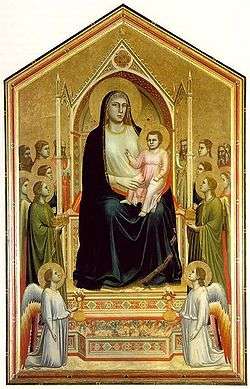



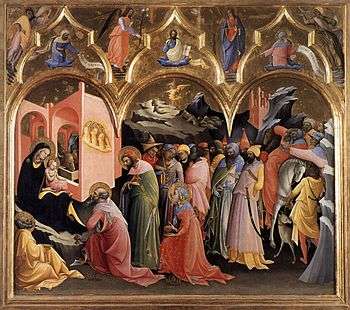
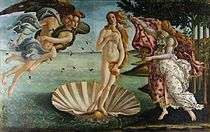
 Sandro Botticelli
Sandro Botticelli
La Primavera, 203 × 314 cm.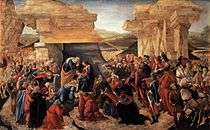 Sandro Botticelli
Sandro Botticelli
Adoration of the Magi, 108 × 173 cm.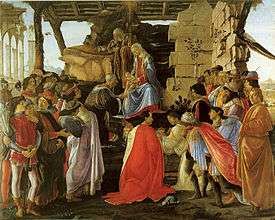 Sandro Botticelli
Sandro Botticelli
Adoration of the Magi, 111 × 134 cm.


 Leonardo da Vinci
Leonardo da Vinci
Annunciation, 98 × 217 cm.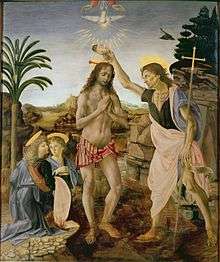





 Titian
Titian
Flora, 80 × 64 cm.

 Raphael
Raphael
Pope Leo X and Family, 154 × 119 cm.

 Giorgione
Giorgione
Moses Trial, 89 × 72 cm..jpg)
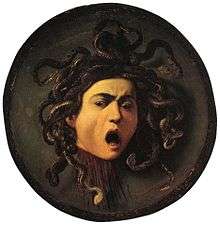 Caravaggio
Caravaggio
Medusa, Diameter 55 cm.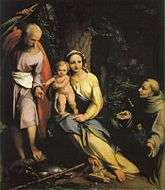 Correggio
Correggio
Rest on Flight to Egypt, 124 × 107 cm.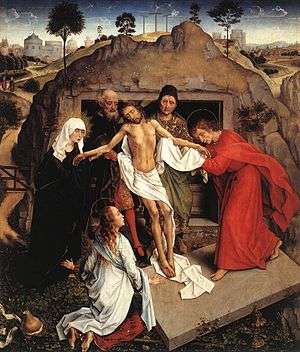

 Hans Memling
Hans Memling
Madonna and Angels, 76 x60 cm.


 Caravaggio
Caravaggio
Young Bacchus, 95 × 85 cm.

 Rembrandt
Rembrandt
Self-Portrait, 74 × 55 cm.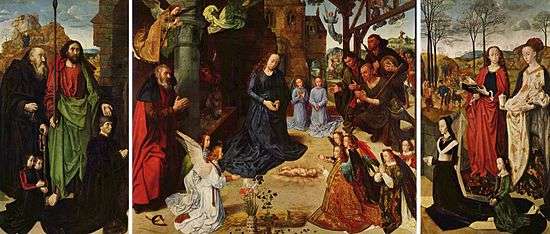




See also
- Collections of the Uffizi
External links
| Wikimedia Commons has media related to |
Notes
- ↑ Official Italian visitor figures, 2016
- ↑ Top 100 Art Museum Attendance, The Art Newspaper, 2014, p. 15. Retrieved on 25 July 2014.
- ↑ http://www.florence-museum.com/uffizi-gallery-tickets.php
- ↑ Official Italian visitor figures, 2016
- ↑ http://www.florence-museum.com/uffizi-gallery-tickets.php?gclid=Cj0KEQjwkN3KBRCu2fWmy9LLqN4BEiQANP9-WiEJRersqPn3481j_HwsmJ4uOR1qBGGtITSC0uYlxJYaAlsT8P8HAQ
- ↑ http://www.uffizi.org/2383-the-botticelli-rooms-reopen/
- ↑ http://www.uffizi.com/history-uffizi-gallery.asp
- ↑ Sigfried Giedion, Space, Time and Architecture (1941) 1962 fig.17.
- ↑ https://www.virtualuffizi.com/tribune.html
- ↑ Fossi, Gloria. The Uffizi. (Giuniti, 1999), p. 8.
- ↑ http://www.florence-museum.com/uffizi-gallery-tickets.php?gclid=Cj0KEQjwkN3KBRCu2fWmy9LLqN4BEiQANP9-WiEJRersqPn3481j_HwsmJ4uOR1qBGGtITSC0uYlxJYaAlsT8P8HAQ
- ↑ http://www.uffizi.org/2383-the-botticelli-rooms-reopen/
- ↑ https://www.reuters.com/article/us-travel-picks-museums-idUSSP17187820080229
- ↑ http://www.nytimes.com/1993/05/28/world/bomb-outside-uffizi-in-florence-kills-6-and-damages-many-works.html
- ↑ http://www.independent.co.uk/news/world/why-florence-still-lives-in-fear-of-the-flood-1350491.html
- ↑ https://www.virtualuffizi.com/new-halls.html
- ↑ http://www.uffizi.org/museum/history/
- ↑ http://www.uffizi.org/2383-the-botticelli-rooms-reopen/
Coordinates: 43°46′06″N 11°15′20″E / 43.7684°N 11.2556°E
